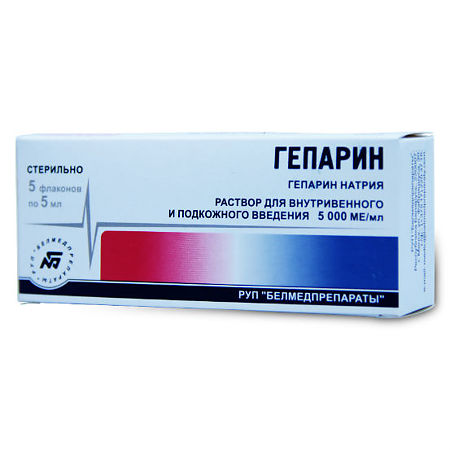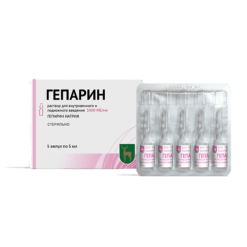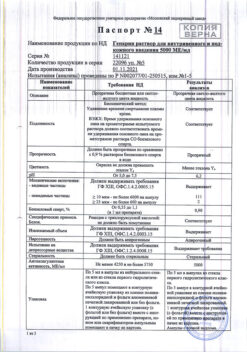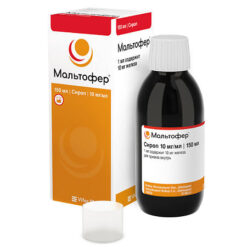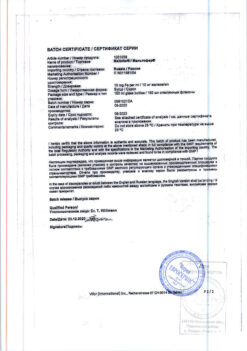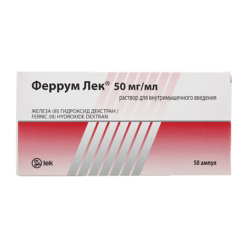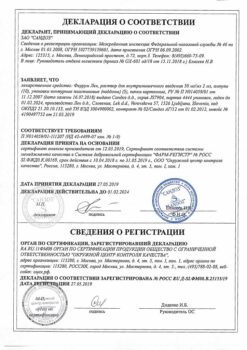No products in the cart.
Heparin, 5000 me/ml 5 ml 5 pcs
€18.82 €16.31
Out of stock
(E-mail when Stock is available)
Description
Heparin is a direct-acting anticoagulant, belongs to the group of medium molecular weight heparins. In blood plasma it activates antithrombin III, accelerating its anticoagulant effect. It disrupts the transition of prothrombin into thrombin, inhibits the activity of thrombin and activated factor X, and to some extent reduces platelet aggregation.
For unfractionated standard heparin, the ratio of antiaggregant activity (antifactor Xa) to anticoagulant activity (ACTV) is 1:1.
increases renal blood flow; increases cerebral vascular resistance, decreases cerebral hyaluronidase activity, activates lipoprotein lipase and has hypolipidemic effects. Reduces surfactant activity in the lungs, suppresses excessive aldosterone synthesis in the adrenal cortex, binds adrenaline, modulates ovarian response to hormonal stimuli, increases parathormone activity. As a result of interaction with enzymes it can increase the activity of brain tyrosine hydroxylase, pepsinogen, DNA polymerase and decrease the activity of myosin ATPase, pyruvate kinase, RNA polymerase, pepsin.
Heparin has been reported to have immunosuppressive activity.
In patients with CHD (in combination with ASA) it reduces the risk of acute coronary artery thrombosis, myocardial infarction and sudden death. Reduces the frequency of recurrent heart attacks and mortality of patients who have had a myocardial infarction. In high doses it is effective for thromboembolism of the pulmonary artery and venous thrombosis; in low doses – for the prevention of venous thromboembolism, including after surgical operations.
In intravenous administration the blood clotting is slowed down almost immediately, in intravenous – after 15-30 min, in p/c – after 20-60 min, after inhalation the maximum effect – after 24 hours; duration of anticoagulant effect – respectively 4-5, 6, 8 hours and 1-2 weeks, therapeutic effect – thrombus formation prevention – lasts significantly longer. Deficiency of antithrombin III in plasma or at the site of thrombosis can reduce the antithrombotic effect of heparin.
When applied externally, it has a local antithrombotic, antiexsudative, moderate anti-inflammatory effect. It blocks the formation of thrombin, inhibits the activity of hyaluronidase, activates the fibrinolytic properties of blood. Heparin penetrating through the skin reduces inflammation and has an antithrombotic effect, improves microcirculation and activates tissue exchange, thus accelerating the process of resorption of hematomas and thromboses and reducing tissue swelling.
Indications
Indications
Active ingredient
Active ingredient
Composition
Composition
Active substance:
Heparin sodium
How to take, the dosage
How to take, the dosage
Intravenous (infusion or injection) or subcutaneous, initial dose is intravenous (injection) 5000 IU, maintenance: continuous intravenous infusion 1000-2000 IU/h (20000-40000 IU/day), previously diluted in 1000 ml isotonic NaCl solution; regular intravenous injections of 5000-10000 IU every 4-6 h; subcutaneous (deep) IU 15000-20000 every 12 h or IU 8000-10000 every 8 h.
Interaction
Interaction
The anticoagulant effect of heparin is enhanced with concomitant use of anticoagulants, antiaggregants and NSAIDs.
The ergot alkaloids, thyroxine, tetracycline, antihistamines, and nicotine reduce the effect of heparin.
Contraindications
Contraindications
Hypersensitivity;
Hemorrhagic diathesis, hemophilia, vasculitis, thrombocytopenia (including one caused by history of heparin. caused by a history of heparin), bleeding, leukemia, increased vascular permeability, polyps, malignant neoplasms and GI ulcers, esophageal varices, severe uncontrolled arterial hypertension, acute bacterial endocarditis, trauma (especially brain injury), recent eye, brain and spine surgery, severe liver and/or kidney dysfunction.
Side effects
Side effects
Nervous system and sensory organs: dizziness, headache.
Cardiovascular system and blood (hematopoiesis, hemostasis): Thrombocytopenia (6% of patients) – early (2-4 days of treatment) and late (autoimmune), in rare cases with fatal outcome; hemorrhagic complications – bleeding from the GI tract or urinary tract, retroperitoneal bleeding in the ovaries, adrenal (with the development of acute adrenal insufficiency).
Gastrointestinal system disorders: decreased appetite, nausea, vomiting, diarrhea, increased level of transaminases in blood.
Allergic reactions: skin hyperemia, drug fever, urticaria, rash, skin itching, bronchospasm, anaphylactoid reactions, anaphylactic shock.
Others: with long-term use – alopecia, osteoporosis, calcification of soft tissues, inhibition of aldosterone synthesis; injection reactions – irritation, hematoma, painfulness when inserted.
Similarities
Similarities
Additional information
| Weight | 0.080 kg |
|---|---|
| Shelf life | 2 years |
| Conditions of storage | In a dry, light-protected place at a temperature not exceeding 25 °C. |
| Manufacturer | Belmedpreparaty, Belarus |
| Medication form | solution |
| Brand | Belmedpreparaty |
Other forms…
Related products
Buy Heparin, 5000 me/ml 5 ml 5 pcs with delivery to USA, UK, Europe and over 120 other countries.

